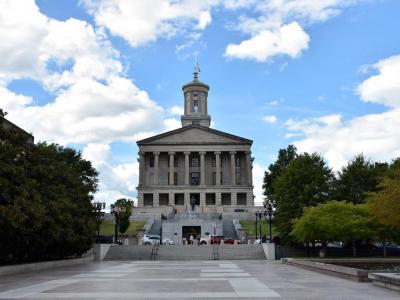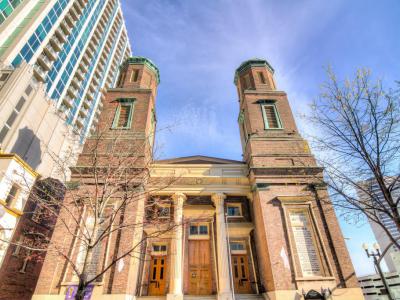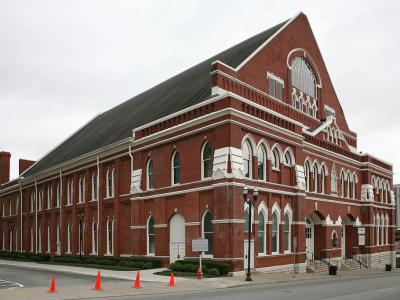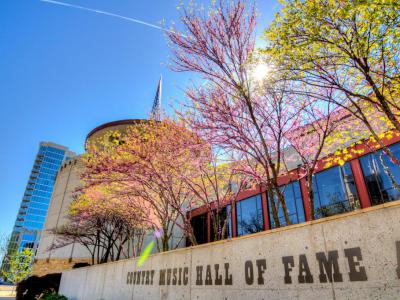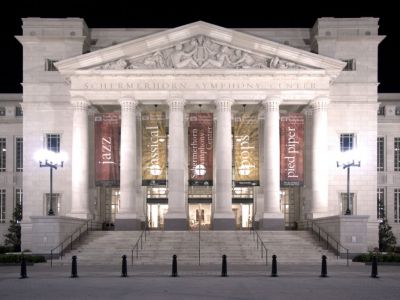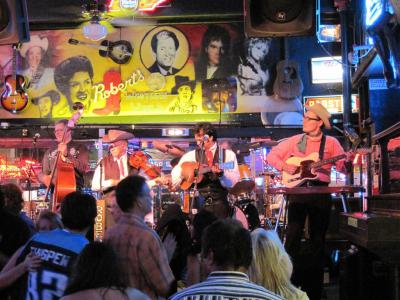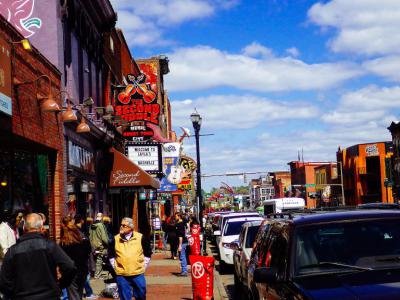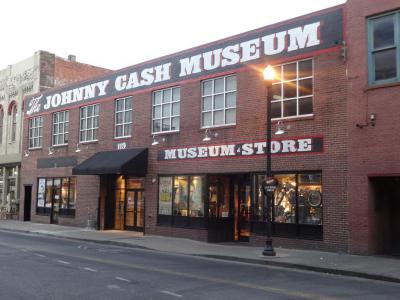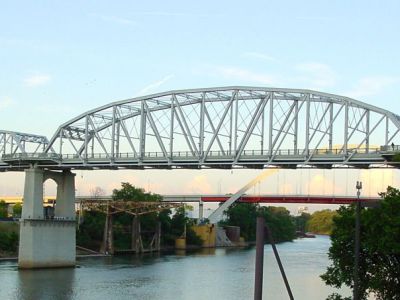
Nashville Introduction Walking Tour (Self Guided), Nashville
They say that Nashville is the coolest place in America "that either you love, or you're wrong." Indeed, the capital city of Tennessee is known for its vibrant music scene, rich history, great culture, and a strong sense of community.
The history of Nashville began in 1779 when James Robertson and John Donelson led a group of settlers to the Cumberland River Valley. The settlement was named after Francis Nash, a Revolutionary War hero.
Nashville quickly grew as a center for trade and commerce, owing to its strategic location on the river and at the crossroads of several major routes. It became the state capital of Tennessee in 1843. Shortly afterward, from 1845 to 1859, the impressive Tennessee State Capitol was built, one of the oldest working seats of power in the nation.
During the Civil War, the city played a significant role as a major transportation hub for the Confederacy. In 1862, it was captured by Union forces and made their headquarters for the rest of the war. After the war, Nashville continued to grow and prosper, becoming a center for industry, education, and culture.
In the early 20th century, the city was popularly known as the "Athens of the South" due to its many educational institutions, as well as its thriving literary and cultural scene.
Starting from the 1920s, Nashville was dubbed "Music City," "fueled by coffee and country music." In part, this was thanks to the success of the Grand Ole Opry radio show, a fixture in Nashville since 1925, which gave rise to and showcased countless country music stars over the years. Many of them are celebrated in the Country Music Hall of Fame and Museum.
Other suchlike landmarks include the Ryman Auditorium, known as the "Mother Church of Country Music," the iconic venue which hosted performances by the likes of Elvis Presley, Dolly Parton, and Johnny Cash. Speaking of Johnny Cash, there is a whole museum in Nashville dedicated to the life and legacy of the legendary "Man in Black."
The city was also a hub for the Civil Rights movement in the 1960s. Martin Luther King famously noted: "I came to Nashville, not to bring inspiration, but to gain inspiration from the great moment that has taken place in this community."
Nashville is a quintessentially American "holy city for music." Some reckon a bad day here is better than a good day anywhere else. Whether true or not, judge for yourself. And if you're lost, return to Nashville.
The history of Nashville began in 1779 when James Robertson and John Donelson led a group of settlers to the Cumberland River Valley. The settlement was named after Francis Nash, a Revolutionary War hero.
Nashville quickly grew as a center for trade and commerce, owing to its strategic location on the river and at the crossroads of several major routes. It became the state capital of Tennessee in 1843. Shortly afterward, from 1845 to 1859, the impressive Tennessee State Capitol was built, one of the oldest working seats of power in the nation.
During the Civil War, the city played a significant role as a major transportation hub for the Confederacy. In 1862, it was captured by Union forces and made their headquarters for the rest of the war. After the war, Nashville continued to grow and prosper, becoming a center for industry, education, and culture.
In the early 20th century, the city was popularly known as the "Athens of the South" due to its many educational institutions, as well as its thriving literary and cultural scene.
Starting from the 1920s, Nashville was dubbed "Music City," "fueled by coffee and country music." In part, this was thanks to the success of the Grand Ole Opry radio show, a fixture in Nashville since 1925, which gave rise to and showcased countless country music stars over the years. Many of them are celebrated in the Country Music Hall of Fame and Museum.
Other suchlike landmarks include the Ryman Auditorium, known as the "Mother Church of Country Music," the iconic venue which hosted performances by the likes of Elvis Presley, Dolly Parton, and Johnny Cash. Speaking of Johnny Cash, there is a whole museum in Nashville dedicated to the life and legacy of the legendary "Man in Black."
The city was also a hub for the Civil Rights movement in the 1960s. Martin Luther King famously noted: "I came to Nashville, not to bring inspiration, but to gain inspiration from the great moment that has taken place in this community."
Nashville is a quintessentially American "holy city for music." Some reckon a bad day here is better than a good day anywhere else. Whether true or not, judge for yourself. And if you're lost, return to Nashville.
How it works: Download the app "GPSmyCity: Walks in 1K+ Cities" from Apple App Store or Google Play Store to your mobile phone or tablet. The app turns your mobile device into a personal tour guide and its built-in GPS navigation functions guide you from one tour stop to next. The app works offline, so no data plan is needed when traveling abroad.
Nashville Introduction Walking Tour Map
Guide Name: Nashville Introduction Walking Tour
Guide Location: USA » Nashville (See other walking tours in Nashville)
Guide Type: Self-guided Walking Tour (Sightseeing)
# of Attractions: 9
Tour Duration: 1 Hour(s)
Travel Distance: 2.1 Km or 1.3 Miles
Author: anna
Sight(s) Featured in This Guide:
Guide Location: USA » Nashville (See other walking tours in Nashville)
Guide Type: Self-guided Walking Tour (Sightseeing)
# of Attractions: 9
Tour Duration: 1 Hour(s)
Travel Distance: 2.1 Km or 1.3 Miles
Author: anna
Sight(s) Featured in This Guide:
- Tennessee State Capitol
- Downtown Presbyterian Church
- Ryman Auditorium
- Country Music Hall of Fame and Museum
- Schermerhorn Symphony Center
- Robert's Western World
- Lower Broadway
- Johnny Cash Museum
- John Seigenthaler Pedestrian Bridge
1) Tennessee State Capitol
The Tennessee State Capitol building is an architectural gem and historic landmark that holds great significance in the state's history and government. Constructed in the Greek Revival style, the Capitol building stands as a symbol of Tennessee's rich heritage and democratic ideals.
Designed by renowned architect William Strickland, the construction of the Tennessee State Capitol began in 1845 and was completed in 1859. The building's exterior is made of Tennessee limestone, giving it a stately and grand appearance. Its iconic dome, inspired by the classical architecture of ancient Greece, rises to a height of approximately 206 feet, making it a prominent feature in the Nashville skyline.
The Capitol building's interior is equally impressive, featuring elaborate details and ornate decorations. The focal point is the House and Senate chambers, adorned with intricate woodwork, elegant chandeliers, and historical artwork. The halls and corridors are adorned with portraits of notable Tennesseans and significant moments in the state's history.
One of the Capitol's most significant historical events occurred during the Civil War. In 1862, during the Battle of Nashville, the building served as a makeshift hospital for wounded soldiers. The bullet holes and scars from that period are still visible on the Capitol's walls, serving as a reminder of the state's tumultuous past.
The Tennessee State Capitol building was named a National Historic Landmark in 1971
Surrounding the Capitol is the beautiful War Memorial Plaza, a space dedicated to honoring Tennesseans who served in various wars and conflicts. The plaza features statues, memorials, and fountains, providing a tranquil space for reflection and remembrance.
The Tennessee State Capitol building is open to the public, welcoming visitors to explore its rich history and architectural grandeur. Guided tours offer insights into the state's government processes, historical significance, and notable events.
Tip:
Be prepared to go through a metal detector and security before entering, but once inside you can wander around on your own. There is a brochure for self-guided tours, though going with a guide is also an option and is definitely the best way to see this beautiful, historic building in the span of an hour or so.
Designed by renowned architect William Strickland, the construction of the Tennessee State Capitol began in 1845 and was completed in 1859. The building's exterior is made of Tennessee limestone, giving it a stately and grand appearance. Its iconic dome, inspired by the classical architecture of ancient Greece, rises to a height of approximately 206 feet, making it a prominent feature in the Nashville skyline.
The Capitol building's interior is equally impressive, featuring elaborate details and ornate decorations. The focal point is the House and Senate chambers, adorned with intricate woodwork, elegant chandeliers, and historical artwork. The halls and corridors are adorned with portraits of notable Tennesseans and significant moments in the state's history.
One of the Capitol's most significant historical events occurred during the Civil War. In 1862, during the Battle of Nashville, the building served as a makeshift hospital for wounded soldiers. The bullet holes and scars from that period are still visible on the Capitol's walls, serving as a reminder of the state's tumultuous past.
The Tennessee State Capitol building was named a National Historic Landmark in 1971
Surrounding the Capitol is the beautiful War Memorial Plaza, a space dedicated to honoring Tennesseans who served in various wars and conflicts. The plaza features statues, memorials, and fountains, providing a tranquil space for reflection and remembrance.
The Tennessee State Capitol building is open to the public, welcoming visitors to explore its rich history and architectural grandeur. Guided tours offer insights into the state's government processes, historical significance, and notable events.
Tip:
Be prepared to go through a metal detector and security before entering, but once inside you can wander around on your own. There is a brochure for self-guided tours, though going with a guide is also an option and is definitely the best way to see this beautiful, historic building in the span of an hour or so.
2) Downtown Presbyterian Church
The Downtown Presbyterian Church, formerly known as First Presbyterian Church, is a unique architectural gem with a storied history. The first structure burned down in 1832, and a second sanctuary was constructed the same year. The third and present sanctuary was constructed in 1848. The church was designated a National Historic Landmark in 1993.
What sets this church apart is its striking Egyptian Revival architecture, which was designed by William Strickland. Strickland, who also designed the Tennessee State Capitol. The church's exterior showcases Egyptian style lotus columns and a winged sun disk, while the interior features stained glass windows, woodwork, and murals of Egyptian scenes. The church's twin towers mirror the design of St. Stephen's Church in Philadelphia, a city Strickland resided in before moving to Nashville.
This church is one of the rare examples of Egyptian Revival architecture in the United States and possibly the best preserved ecclesiastical example. Other surviving churches in the U.S. with Egyptian architectural themes include the First Baptist Church of Essex, Connecticut, and the First Presbyterian Church in Sag Harbor, New York.
The Downtown Presbyterian Church has also been the site of several historic events and persons. President Andrew Jackson was a member of the church when it was still known as First Presbyterian Church. He was presented with a ceremonial sword on the steps of the original church following the Battle of New Orleans. Additionally, Tennessee Governor James K. Polk was inaugurated in the church's second sanctuary. During the Civil War, the church was seized by Federal forces and used as a military hospital, temporarily becoming Nashville's Union Hospital No. 8.
Over the years, the church has served as a sanctuary for Nashville's citizens, sheltering them from floods in the 1920s and providing refuge to soldiers during the Second World War. The church continues to engage in active social ministry, offering support to the less fortunate.
What sets this church apart is its striking Egyptian Revival architecture, which was designed by William Strickland. Strickland, who also designed the Tennessee State Capitol. The church's exterior showcases Egyptian style lotus columns and a winged sun disk, while the interior features stained glass windows, woodwork, and murals of Egyptian scenes. The church's twin towers mirror the design of St. Stephen's Church in Philadelphia, a city Strickland resided in before moving to Nashville.
This church is one of the rare examples of Egyptian Revival architecture in the United States and possibly the best preserved ecclesiastical example. Other surviving churches in the U.S. with Egyptian architectural themes include the First Baptist Church of Essex, Connecticut, and the First Presbyterian Church in Sag Harbor, New York.
The Downtown Presbyterian Church has also been the site of several historic events and persons. President Andrew Jackson was a member of the church when it was still known as First Presbyterian Church. He was presented with a ceremonial sword on the steps of the original church following the Battle of New Orleans. Additionally, Tennessee Governor James K. Polk was inaugurated in the church's second sanctuary. During the Civil War, the church was seized by Federal forces and used as a military hospital, temporarily becoming Nashville's Union Hospital No. 8.
Over the years, the church has served as a sanctuary for Nashville's citizens, sheltering them from floods in the 1920s and providing refuge to soldiers during the Second World War. The church continues to engage in active social ministry, offering support to the less fortunate.
3) Ryman Auditorium (must see)
Ryman Auditorium, also known as the "Mother Church of Country Music," is a historic venue in downtown Nashville. Established by Thomas G. Ryman, it has become one of the most iconic landmarks in the country music industry.
Thomas Ryman was a businessman and riverboat captain who was converted to Christianity during a revival meeting led by evangelist Reverend Sam Jones. Inspired by his new faith, Ryman decided to build a tabernacle to host large revival meetings and to support Jones's ministry. Construction of the Union Gospel Tabernacle began in 1885 and was completed in 1892. After Ryman's death in 1904, the building was renamed the Ryman Auditorium in his honor.
Although initially built for religious purposes, Ryman Auditorium has been used for a variety of events over the years. In the early 20th century, it hosted political debates, community meetings, and various entertainment programs. It served as the home of the Grand Ole Opry, the world's longest-running live radio show, from 1943 to 1974, which marked the beginning of its reputation as the "Mother Church of Country Music."
Some of the biggest names in the music industry, including Johnny Cash, Elvis Presley, Hank Williams, Dolly Parton, and Patsy Cline, have performed on the Ryman stage. The venue is renowned for its exceptional acoustics, which contribute to the unique sound and atmosphere that attract musicians and audiences alike.
Despite the introduction of modern venues in Nashville, the Ryman Auditorium has held onto its charm and historical significance. It fell into disrepair when the Grand Ole Opry moved to a new location in 1974, but it was renovated and reopened in 1994. Since then, it has continued to host a variety of music performances, including country, rock, bluegrass, gospel, and pop.
Today Ryman Auditorium is a treasured symbol of Nashville's musical heritage and a must-visit destination for music lovers worldwide.
Tip:
There are two options on tours; self-guided and guided. With the former you can roam about the amphitheater and balcony levels, enjoying the many displays on the auditorium, its history, and the many diverse artists and orators who have visited the stage. If you're really into it, buy the (extra-cost) guided backstage tour tickets, and the guide will take you backstage through many of the dressing rooms, with history about the place and the artists included. Ending up at the side of the stage at the control area where you can grab a pic looking out into the bowl, you are then free to roam around the rest of the place with the other visitors. Pictures are allowed everywhere except in the dressing rooms on the backstage tour.
Thomas Ryman was a businessman and riverboat captain who was converted to Christianity during a revival meeting led by evangelist Reverend Sam Jones. Inspired by his new faith, Ryman decided to build a tabernacle to host large revival meetings and to support Jones's ministry. Construction of the Union Gospel Tabernacle began in 1885 and was completed in 1892. After Ryman's death in 1904, the building was renamed the Ryman Auditorium in his honor.
Although initially built for religious purposes, Ryman Auditorium has been used for a variety of events over the years. In the early 20th century, it hosted political debates, community meetings, and various entertainment programs. It served as the home of the Grand Ole Opry, the world's longest-running live radio show, from 1943 to 1974, which marked the beginning of its reputation as the "Mother Church of Country Music."
Some of the biggest names in the music industry, including Johnny Cash, Elvis Presley, Hank Williams, Dolly Parton, and Patsy Cline, have performed on the Ryman stage. The venue is renowned for its exceptional acoustics, which contribute to the unique sound and atmosphere that attract musicians and audiences alike.
Despite the introduction of modern venues in Nashville, the Ryman Auditorium has held onto its charm and historical significance. It fell into disrepair when the Grand Ole Opry moved to a new location in 1974, but it was renovated and reopened in 1994. Since then, it has continued to host a variety of music performances, including country, rock, bluegrass, gospel, and pop.
Today Ryman Auditorium is a treasured symbol of Nashville's musical heritage and a must-visit destination for music lovers worldwide.
Tip:
There are two options on tours; self-guided and guided. With the former you can roam about the amphitheater and balcony levels, enjoying the many displays on the auditorium, its history, and the many diverse artists and orators who have visited the stage. If you're really into it, buy the (extra-cost) guided backstage tour tickets, and the guide will take you backstage through many of the dressing rooms, with history about the place and the artists included. Ending up at the side of the stage at the control area where you can grab a pic looking out into the bowl, you are then free to roam around the rest of the place with the other visitors. Pictures are allowed everywhere except in the dressing rooms on the backstage tour.
4) Country Music Hall of Fame and Museum (must see)
The Country Music Hall of Fame and Museum is one of the world's largest museums and research centers dedicated to the preservation and interpretation of American country music.
Founded in 1964, the museum's mission is to document the history of country music, an art form that has had a significant impact on the culture of the United States and beyond. It's often considered the definitive home for country music, given Nashville's storied connection to the genre.
The museum's architecture itself is a tribute to country music. The building's unique design features a piano keyboard merging into a car grille on one side and a Cadillac tailfin on the other, symbols that reflect country music's deep ties to southern culture. The museum's windows replicate the black diamond shapes found on a WSM radio tower, the station that broadcasts the Grand Ole Opry.
The Country Music Hall of Fame and Museum's expansive collection includes over 2.5 million artifacts. It features sound recordings, photographs, films, and a variety of musical instruments used by country music's most influential figures. Items such as Elvis Presley's "Solid Gold" Cadillac and Jimmie Rodgers' guitar can be found within the museum.
In addition to its vast collection, the museum also includes the 776-seat CMA Theater, the 213-seat Ford Theater, and the Taylor Swift Education Center. It hosts educational programs, live performances, public programs, exhibitions, and serves as a venue for artist interviews and panels.
The Hall of Fame Rotunda, part of the museum, is a sacred place where members of the Hall of Fame are commemorated with bronze plaques. The selection process is tightly controlled and being inducted into the Country Music Hall of Fame is considered one of the highest honors in the genre.
Tip:
Be sure to check the museum website for live music options. Also, consider getting the RCA Studio B tour combo ticket.
Founded in 1964, the museum's mission is to document the history of country music, an art form that has had a significant impact on the culture of the United States and beyond. It's often considered the definitive home for country music, given Nashville's storied connection to the genre.
The museum's architecture itself is a tribute to country music. The building's unique design features a piano keyboard merging into a car grille on one side and a Cadillac tailfin on the other, symbols that reflect country music's deep ties to southern culture. The museum's windows replicate the black diamond shapes found on a WSM radio tower, the station that broadcasts the Grand Ole Opry.
The Country Music Hall of Fame and Museum's expansive collection includes over 2.5 million artifacts. It features sound recordings, photographs, films, and a variety of musical instruments used by country music's most influential figures. Items such as Elvis Presley's "Solid Gold" Cadillac and Jimmie Rodgers' guitar can be found within the museum.
In addition to its vast collection, the museum also includes the 776-seat CMA Theater, the 213-seat Ford Theater, and the Taylor Swift Education Center. It hosts educational programs, live performances, public programs, exhibitions, and serves as a venue for artist interviews and panels.
The Hall of Fame Rotunda, part of the museum, is a sacred place where members of the Hall of Fame are commemorated with bronze plaques. The selection process is tightly controlled and being inducted into the Country Music Hall of Fame is considered one of the highest honors in the genre.
Tip:
Be sure to check the museum website for live music options. Also, consider getting the RCA Studio B tour combo ticket.
5) Schermerhorn Symphony Center
The Schermerhorn Symphony Center is a world-class concert hall located in the heart of downtown Nashville. Opened in September 2006, this beautiful neoclassical building serves as the home of the esteemed Nashville Symphony. The center was named in honor of the late Maestro Kenneth Schermerhorn, who served as music director of the Nashville Symphony for 22 years.
The Schermerhorn Symphony Center stands as a testament to the classical architectural design combined with modern, state-of-the-art acoustics. This elegant venue boasts a variety of unique features, including a custom-built organ, seating over 1,800 patrons, and the Martha Rivers Ingram Garden Courtyard, which provides an outdoor space for audiences to gather before concerts and during intermissions.
Inside the center's main venue, the Laura Turner Concert Hall, visitors are captivated by its striking beauty and versatile design, which can be transformed from a traditional concert hall into a flat floor suitable for a variety of events, such as banquets or dances. The hall's impressive acoustics, thanks to innovative design and technology, make it one of the finest performance venues in the country.
The Schermerhorn Symphony Center is not just a venue for symphonic performances, but a thriving cultural center for the Nashville community. It hosts a variety of events throughout the year, including pop, jazz, and world music concerts, educational programs, and community events.
Tip:
If you attend a symphony performance, don't miss the post-concert talk with the conductor. It is intimate and a wonderful end to a great time.
The Schermerhorn Symphony Center stands as a testament to the classical architectural design combined with modern, state-of-the-art acoustics. This elegant venue boasts a variety of unique features, including a custom-built organ, seating over 1,800 patrons, and the Martha Rivers Ingram Garden Courtyard, which provides an outdoor space for audiences to gather before concerts and during intermissions.
Inside the center's main venue, the Laura Turner Concert Hall, visitors are captivated by its striking beauty and versatile design, which can be transformed from a traditional concert hall into a flat floor suitable for a variety of events, such as banquets or dances. The hall's impressive acoustics, thanks to innovative design and technology, make it one of the finest performance venues in the country.
The Schermerhorn Symphony Center is not just a venue for symphonic performances, but a thriving cultural center for the Nashville community. It hosts a variety of events throughout the year, including pop, jazz, and world music concerts, educational programs, and community events.
Tip:
If you attend a symphony performance, don't miss the post-concert talk with the conductor. It is intimate and a wonderful end to a great time.
6) Robert's Western World
Robert's Western World is an iconic honky-tonk bar located in the heart of Nashville's legendary Lower Broadway district. Renowned for its live country music, historical ambiance, and classic Nashville hospitality, Robert's Western World is a must-visit establishment for music enthusiasts and lovers of Americana.
This celebrated venue is housed in a building that once served as the warehouse for the city's famed shoemakers, Friedman's, before evolving into one of Music City's most beloved honky-tonks. Stepping inside Robert's is like stepping back in time, as the bar proudly preserves a retro atmosphere that pays homage to the golden era of country music.
The wall decor features shelves of cowboy boots, neon beer signs, decorative markers of rural authenticity, and photos of country music's most iconic performers, such as Ernest Tubb, Jimmie Rodgers, Hank Williams, Patsy Cline, Minnie Pearl, Marty Robbins, and Roy Acuff.
Robert's Western World is revered for its authentic country and western swing music, with live performances happening every day of the week. Here, you'll find local legends and up-and-coming artists alike taking the stage, often playing classic tunes that span the rich history of country music.
Beyond the music, Robert's is known for its comfort food and wide selection of beers, but perhaps most famous is its "Recession Special," a fried bologna sandwich, chips, and a Pabst Blue Ribbon beer, all for a throwback price.
This celebrated venue is housed in a building that once served as the warehouse for the city's famed shoemakers, Friedman's, before evolving into one of Music City's most beloved honky-tonks. Stepping inside Robert's is like stepping back in time, as the bar proudly preserves a retro atmosphere that pays homage to the golden era of country music.
The wall decor features shelves of cowboy boots, neon beer signs, decorative markers of rural authenticity, and photos of country music's most iconic performers, such as Ernest Tubb, Jimmie Rodgers, Hank Williams, Patsy Cline, Minnie Pearl, Marty Robbins, and Roy Acuff.
Robert's Western World is revered for its authentic country and western swing music, with live performances happening every day of the week. Here, you'll find local legends and up-and-coming artists alike taking the stage, often playing classic tunes that span the rich history of country music.
Beyond the music, Robert's is known for its comfort food and wide selection of beers, but perhaps most famous is its "Recession Special," a fried bologna sandwich, chips, and a Pabst Blue Ribbon beer, all for a throwback price.
7) Lower Broadway (must see)
Lower Broadway is a vibrant and bustling street located in the heart of downtown Nashville. Often referred to as the city's entertainment district, Lower Broadway is renowned for its legendary honky-tonks, live country music, and southern hospitality, earning it the affectionate nickname "Honky Tonk Highway."
Running from 1st to 5th Avenue, Lower Broadway is lined with neon-lit venues, restaurants, souvenir shops, and landmarks steeped in music history. It's the beating heart of Nashville's country music scene, where both aspiring musicians and established country stars alike perform for locals and tourists.
Several iconic venues dot the street, including Tootsie's Orchid Lounge, Legends Corner, and Robert's Western World, each offering live music from early afternoon into the early hours of the morning. The street is also home to the Johnny Cash Museum, recognizing the life and music of one of country music's most influential artists.
At the end of Lower Broadway sits the Cumberland River, and the majestic riverfront views serve as the backdrop to the Ascend Amphitheater, a modern outdoor venue. A short stroll away is the Country Music Hall of Fame and Museum and the Bridgestone Arena, further embedding the street in the rich tapestry of Nashville's music scene.
Lower Broadway's energetic atmosphere and non-stop live music make it a favorite for locals and a must-visit for visitors seeking the authentic Nashville experience. Whether you're a lifelong country music fan, a budding musician, or a curious traveler, Lower Broadway offers a unique glimpse into the soul of Music City.
Running from 1st to 5th Avenue, Lower Broadway is lined with neon-lit venues, restaurants, souvenir shops, and landmarks steeped in music history. It's the beating heart of Nashville's country music scene, where both aspiring musicians and established country stars alike perform for locals and tourists.
Several iconic venues dot the street, including Tootsie's Orchid Lounge, Legends Corner, and Robert's Western World, each offering live music from early afternoon into the early hours of the morning. The street is also home to the Johnny Cash Museum, recognizing the life and music of one of country music's most influential artists.
At the end of Lower Broadway sits the Cumberland River, and the majestic riverfront views serve as the backdrop to the Ascend Amphitheater, a modern outdoor venue. A short stroll away is the Country Music Hall of Fame and Museum and the Bridgestone Arena, further embedding the street in the rich tapestry of Nashville's music scene.
Lower Broadway's energetic atmosphere and non-stop live music make it a favorite for locals and a must-visit for visitors seeking the authentic Nashville experience. Whether you're a lifelong country music fan, a budding musician, or a curious traveler, Lower Broadway offers a unique glimpse into the soul of Music City.
8) Johnny Cash Museum (must see)
The Johnny Cash Museum, located in downtown Nashville, Tennessee, is a tribute to one of the most influential musicians of the 20th century. Dedicated to preserving the legacy of "The Man in Black," the museum offers an in-depth look at Johnny Cash's life, music, and impact on the world.
Opened in 2013, the museum was founded by Bill Miller, a close friend of Cash, and is considered the largest archive of Johnny Cash artifacts and memorabilia in the world. It houses a comprehensive collection that includes stage costumes, instruments, personal letters, artwork, and handwritten song lyrics, as well as rare recordings and photographs.
The exhibits within the Johnny Cash Museum tell a chronological story of Cash's extraordinary life, starting with his early years in Dyess, Arkansas, through his legendary music career, to his enduring influence on music and culture. Interactive exhibits and a series of films also provide a multifaceted exploration of Cash's work and his contributions to country music and American history.
The museum has received numerous accolades and is considered one of the best music museums in the world. It is not just a destination for Johnny Cash fans, but also for anyone interested in the history of American music, providing a profound understanding of the man behind the music, his values, and his lasting influence on the music industry.
Opened in 2013, the museum was founded by Bill Miller, a close friend of Cash, and is considered the largest archive of Johnny Cash artifacts and memorabilia in the world. It houses a comprehensive collection that includes stage costumes, instruments, personal letters, artwork, and handwritten song lyrics, as well as rare recordings and photographs.
The exhibits within the Johnny Cash Museum tell a chronological story of Cash's extraordinary life, starting with his early years in Dyess, Arkansas, through his legendary music career, to his enduring influence on music and culture. Interactive exhibits and a series of films also provide a multifaceted exploration of Cash's work and his contributions to country music and American history.
The museum has received numerous accolades and is considered one of the best music museums in the world. It is not just a destination for Johnny Cash fans, but also for anyone interested in the history of American music, providing a profound understanding of the man behind the music, his values, and his lasting influence on the music industry.
9) John Seigenthaler Pedestrian Bridge (must see)
The John Seigenthaler Pedestrian Bridge, previously known as the Shelby Street Bridge, is a landmark in Nashville. Constructed in 1909 and spanning the Cumberland River, it was one of the first bridges in the country designed exclusively for automobile traffic. However, today it serves as one of the most scenic pedestrian thoroughfares in the city.
The bridge was renamed in 2014 to honor John Seigenthaler, a notable figure in the Nashville community who served as editor and publisher of The Tennessean, was a founding editorial director of USA Today, and made significant contributions to the Civil Rights Movement.
Originally, this truss bridge was intended to connect downtown Nashville with East Nashville. However, after closing to vehicular traffic in 1998 due to structural concerns, it was preserved and renovated into a pedestrian bridge, reopening in 2003.
Spanning nearly 3,150 feet, the John Seigenthaler Pedestrian Bridge provides an outstanding vantage point for viewing the Nashville skyline and the Cumberland River. It is frequently used by pedestrians and cyclists and is a popular spot for tourist photos.
The bridge also serves as a gathering place for community events. It is part of the course for the Country Music Marathon and is a popular viewing area for Nashville’s Fourth of July fireworks display.
John Seigenthaler Pedestrian Bridge is a perfect place for enjoying a leisurely walk, a brisk jog, or simply taking in the stunning panoramic views of downtown Nashville.
The bridge was renamed in 2014 to honor John Seigenthaler, a notable figure in the Nashville community who served as editor and publisher of The Tennessean, was a founding editorial director of USA Today, and made significant contributions to the Civil Rights Movement.
Originally, this truss bridge was intended to connect downtown Nashville with East Nashville. However, after closing to vehicular traffic in 1998 due to structural concerns, it was preserved and renovated into a pedestrian bridge, reopening in 2003.
Spanning nearly 3,150 feet, the John Seigenthaler Pedestrian Bridge provides an outstanding vantage point for viewing the Nashville skyline and the Cumberland River. It is frequently used by pedestrians and cyclists and is a popular spot for tourist photos.
The bridge also serves as a gathering place for community events. It is part of the course for the Country Music Marathon and is a popular viewing area for Nashville’s Fourth of July fireworks display.
John Seigenthaler Pedestrian Bridge is a perfect place for enjoying a leisurely walk, a brisk jog, or simply taking in the stunning panoramic views of downtown Nashville.
Walking Tours in Nashville, Tennessee
Create Your Own Walk in Nashville
Creating your own self-guided walk in Nashville is easy and fun. Choose the city attractions that you want to see and a walk route map will be created just for you. You can even set your hotel as the start point of the walk.
Music Valley Walking Tour
Ten miles from the center of Nashville, Tennessee, the Cumberland River winds its way around Opryland, embracing the flow of sound waves coming from the best country music acts on the planet. Music Valley, a vibrant neighborhood in the eastern part of the city, is centered around the famous Music Valley Drive and is known for its deep connection to Nashville's rich musical heritage.
One... view more
Tour Duration: 2 Hour(s)
Travel Distance: 2.8 Km or 1.7 Miles
One... view more
Tour Duration: 2 Hour(s)
Travel Distance: 2.8 Km or 1.7 Miles
Downtown Music and Food
It seems like everywhere you walk in Nashville, there’s great music coming out of every wall. Indeed, Nashville is famously regarded as the "Music City" and its Downtown is at the heart of this vibrant music scene. But that's not all. In fact, the busy streets of Downtown Nashville are as much a music lover's paradise as they are a foodie's joy, as there are dozens of... view more
Tour Duration: 1 Hour(s)
Travel Distance: 0.7 Km or 0.4 Miles
Tour Duration: 1 Hour(s)
Travel Distance: 0.7 Km or 0.4 Miles
The Most Popular Cities
/ view all
